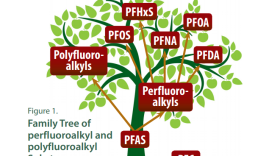The U.S. Environmental Protection Agency has taken the next step toward setting drinking water limits for two PFAS chemicals — PFOA and PFOS. Environmentalists say the step is small and they want to see quicker, bolder action.
The EPA has proposed a so-called regulatory determination to set a national drinking water standard for PFOA and PFOS, emerging contaminants found in Hoosick Falls and Newburgh, respectively. Melanie Benesh is legislative attorney with the Washington D.C.-headquartered Environmental Working Group. She says it could be years, however, before EPA sets final, enforceable standards, if at all.
“This is definitely regulation moving at a snail’s pace, and it’s really years overdue,” says Benesh.
In addition to proposing to regulate PFOS and PFOA, EPA is asking for information and data on other PFAS substances, as well as seeking comment on potential monitoring requirements and regulatory approaches the agency is considering for PFAS chemicals. Liz Moran is environmental policy director for the New York Public Interest Research Group.
“So they’ve taken it a notch forward. We do think that this is a positive step. They’re certainly hearing the outcry from the public. People are deeply concerned about the widespread use of these chemicals and how widespread it’s now becoming prevalent in people’s drinking water,” Moran says. “So this is the right step but, that said, states shouldn’t wait for the fact that this could be a really long process, and states like New York need to make sure we are setting drinking water standards that are stringer and aligned with the most conservative health science.”
In New York, the Drinking Water Quality Council has recommended 10 parts per trillion for PFOA and PFOS each and 1 part per billion for 1,4-Dioxane, levels the state Department of Health is anticipated to adopt in the coming months. NYPIRG and others had been pushing for even lower levels. Environmental Working Group’s Benesh agrees states need to take the lead.
“PFAS is a chemical that’s in the blood of virtually every living being, and it’s really hard to overstate the urgency that there is for the government to step in and make real meaningful regulations on these chemicals,” Benesh says. “And what the agency has done in the last week is a positive step forward, but more needs to be done and needs to be done quickly.”
Another proposal EPA issued the same day would restrict some uses of so-called long-chain PFAS chemicals. Benesh says it’s a rehash of a 2015 proposal.
“And what that does is codify some of those voluntary phase-out of particular kinds of PFAS chemicals that industry agreed to under pressure from EPA,” Benesh says.
As part of its PFAS Action Plan, the agency is proposing regulations on imported products that contain certain long-chain PFAS chemicals used as surface coatings. EPA Administrator Andrew Wheeler says the regulation would close a loophole. While EPA believes the use of these chemicals as surface coatings in imported goods has been phased out, this proposal would ensure that EPA reviews any new uses for surface coatings on products such as furniture, automobile parts and household appliances, before such products could be imported. Again, Benesh.
“And so what it means is if you’re going to start using these chemicals again, you have to get permission from EPA first,” Benesh says. “So it’s not a complete ban but it’s more regulation than what currently exists.”
NYPIRG’s Moran says something is missing from this bill and others that address PFOA and PFOS.
“We really want to closely check the language there to make sure it’s as strong as possible, so we’ll have to eye the language they propose,” says Moran. “And we also have to make sure we start looking at short-chain PFAS.
Meantime, Democratic New York Congressman Antonio Delgado recently wrote to EPA Regional Administrator Pete Lopez following up on topics Lopez addressed at a Hoosick Falls Community Working Group meeting in January.
“We’re still hoping that they will take on and set a maximum contaminant level, something they can do again on their own accord, but they have not. So I made a point to stress to Mr. Lopez we need a timeline, we need to understand where the urgency is. And he explained that he’d get back to me with that timeline. And so we’ll see what it looks like,” Delgado says. “But it’s a big issue for our communities and we’ve got to get something done in this space. And we’ve got a lot of bills we’ve introduced, and I want to get something done beyond the Toxic Release Inventory.”
That bill, the PFAS Right-to-Know Act, requires per-and polyfluoroalkyl chemicals (PFAS) to be listed on the Toxics Release Inventory (TRI) at the EPA. Delgado says this should have been something for the EPA to accomplish, not Congress.











